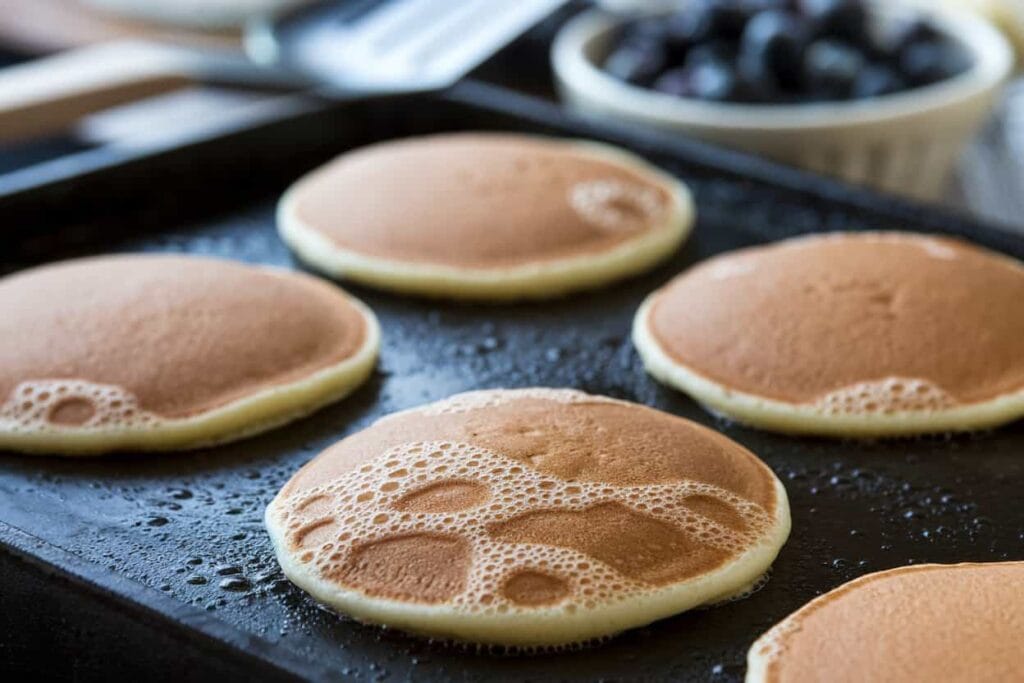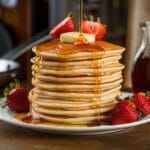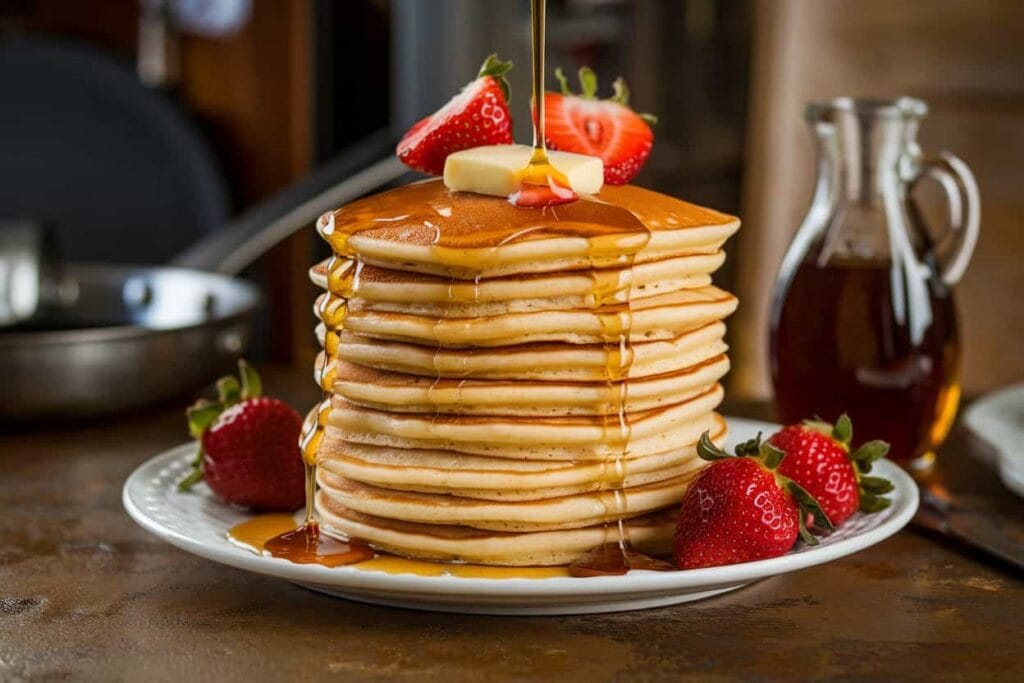Pancakes just the word brings up thoughts of fluffy, golden goodness topped with syrup and butter. But let’s face it, even though pancakes seem simple, getting the perfect batter is no easy feat. You’re probably here because you’ve asked yourself: “Pancake Water-to-Mix Ratio, what is it?” Don’t worry! We’ve got you covered with all the tips, tricks, and science to make your pancake mornings stress-free and delicious.
Pancake Water-to-Mix Ratio
Before we dive deep, let’s start with the basics. The ratio of water to pancake mix essentially determines the consistency of your batter. Too thick? You’ll end up with doughy, undercooked pancakes. Too runny? Say hello to floppy, thin pancakes. The secret is striking that perfect balance to create light and fluffy pancakes every time.
Why Understanding Ratios Matters for Pancakes
If you’ve ever wondered why your pancakes don’t quite match the ones from your favorite diner, it’s often because of one thing—ratios. Getting the water-to-mix ratio right is critical because:
- It impacts how your pancakes rise and cook.
- It determines the texture (fluffy vs. thin).
- It ensures even cooking and prevents sticking.
Think of this as your foundation. Like building a house, if the base isn’t solid, nothing else will work!
The Science Behind Pancake Water-to-Mix Ratio
Pancake batter works on a simple principle of hydration. Water activates the dry ingredients in your mix, creating the chemical reactions needed to make your pancakes rise and become tender. Too much water can dilute these reactions, while too little can make the batter stiff.
Achieving the Perfect Consistency
The perfect pancake batter should resemble a smooth, slightly runny paste. Imagine honey dripping off a spoon—thick enough to hold some shape but loose enough to pour effortlessly.
Common Pancake Water-to-Mix Ratio Explained

Now let’s get practical. Every pancake mix brand has its own recommended ratio, but a good rule of thumb for most store-bought mixes is:
| Mix Type | Water-to-Mix Ratio |
|---|---|
| Standard Pancake Mix | 1:1 (1 cup mix, 1 cup water) |
| Thicker Pancakes | 1:0.75 (1 cup mix, ¾ cup water) |
| Thinner Crepes | 1:1.25 (1 cup mix, 1¼ cups water) |
Standard Ratios for Store-Bought Mixes
If you’re using a classic brand like Bisquick or Aunt Jemima, the instructions usually follow the 1:1 rule. This means for every cup of mix, you’ll need one cup of water. Simple, right? But don’t be afraid to tweak this based on your preferences!
Adjusting Ratios for Homemade Pancake Water-to-Mix Ratio
Making your own mix? Awesome! For homemade mixes, the standard ratio is still a good starting point, but you may need to adjust depending on the type of flour and ingredients you use. Whole grain flours, for example, often absorb more water than white flour.
Factors That Influence the Pancake Water-to-Mix Ratio
Now that you’ve got the basics, let’s talk about what can mess up your perfect pancake plan. From the type of mix to your kitchen environment, there are a few sneaky factors that can throw off your batter.
Type of Pancake Mix
Not all pancake mixes are created equal. Some have added ingredients like milk powder, which means they’ll need less water. Others, especially protein-rich mixes, might require a bit more liquid to loosen things up.
Desired Pancake Texture and Thickness
Are you a fan of thick, fluffy pancakes? Or do you prefer thin, crepe-like ones? Your preferred texture will dictate how much water to add. More water equals thinner batter and thinner pancakes.
Elevation and Environmental Factors
Believe it or not, elevation and humidity play a role in pancake ratios! If you’re cooking at high altitudes, you may need more liquid to keep the batter from drying out too quickly. In humid areas, less water might be required.
Common Problems with Pancake Water-to-Mix Ratio
Alright, let’s address the elephant in the room: what happens when things go wrong? Don’t worry; even the best chefs have been there.
Batter Too Thick
If your batter looks more like cookie dough than pancake mix, it’s probably too thick. This often happens when you’re eyeballing measurements or adding extra dry ingredients without adjusting the liquid.
Batter Too Thin
Runny batter is another common issue. If your pancakes are spreading too much on the griddle and looking like pancakes’ flat cousin (a crepe), your batter is too thin.
Uneven Texture in Pancake Water-to-Mix Ratio
Ever bitten into a pancake only to find lumps or an undercooked center? This could be due to inconsistent mixing or an imbalanced water-to-mix ratio.
“Pro Tip: Mix gently but thoroughly to avoid lumps while keeping your batter airy and light.”
How to Correct Pancake Batter Issues
Mistakes happen, but don’t worry—there are simple fixes for common pancake batter problems. Whether your batter is too thick, too thin, or uneven, you can get it back on track with a few tweaks.
Fixing Thick Batter
If your batter feels like cement, adding a bit of liquid will save the day. Gradually stir in small amounts of water, milk, or an alternative liquid (like almond milk) until you reach the desired consistency. Go slow to avoid over-thinning it.
“Start with a tablespoon of liquid at a time and mix well after each addition. Patience is key!”
Fixing Thin Batter
Runny batter is easier to fix than you might think. Simply add a little more pancake mix to thicken it up. If you don’t have extra mix on hand, a tablespoon of all-purpose flour will work in a pinch. Stir gently to combine and test the consistency before adding more.
Improving Uneven Texture
Uneven texture often comes from over-mixing or under-mixing. For lumpy batter, whisk gently but thoroughly to break up the clumps. For batter that’s too smooth (which can lead to tough pancakes), let it rest for 5–10 minutes to allow the ingredients to settle.
Expert Tips for Perfect Pancake Water-to-Mix Ratio
Want to take your pancake game to the next level? These expert tips will help you nail the perfect water-to-mix ratio every time.
Measuring Techniques for Consistency
Always measure your ingredients accurately. Use a liquid measuring cup for water and a dry measuring cup for your mix. Level off the dry mix with a knife to ensure you’re not accidentally packing in too much.
Experimenting with Water Amounts
Think of pancake making as a science experiment. Start with the standard ratio, then adjust to suit your preferences. Like fluffier pancakes? Use less water. Want them thinner and crispier? Add a touch more liquid. It’s all about finding your sweet spot.
Customizing Your Pancake Batter Ratio
One of the best things about pancakes is how customizable they are. Once you’ve mastered the basic ratio, you can start experimenting with add-ins and alternative liquids to create unique flavors and textures.
Adding Milk or Alternative Liquids
Substituting water with milk (or a non-dairy alternative like oat milk) can add richness and flavor to your pancakes. Keep in mind that milk is thicker than water, so you may need to slightly adjust the amount to get the right consistency.
Adjusting for Add-ins Like Fruits or Chocolate
Planning to add blueberries, chocolate chips, or bananas to your batter? Remember that these add-ins can affect the consistency. Fruits, for example, release moisture as they cook, so consider using slightly less water in the batter if you’re adding a lot of mix-ins.
Pancake Mix Brands and Their Recommended Ratios
Every pancake mix brand is a little different, so let’s break down some of the most popular ones and their recommended ratios.
| Brand | Water-to-Mix Ratio | Special Instructions |
|---|---|---|
| Bisquick | 1:1 | Add an egg for extra fluffiness. |
| Aunt Jemima | 1:1 | Optionally use milk instead of water. |
| Krusteaz | 1:1.25 | Mix until slightly lumpy for best results. |
Comparing Popular Pancake Mix Brands
Each brand has its unique characteristics. For example, Krusteaz tends to create thinner pancakes, while Bisquick produces thicker, fluffier ones. Use the ratios as guidelines and adjust according to your preferences.
Tips for Following Package Instructions
Always read the package instructions carefully, but don’t be afraid to make adjustments. Think of the listed ratios as a starting point, not a strict rule. Use your judgment based on the texture of the batter.
Testing Your Pancake Batter Consistency

Once your batter is mixed, it’s time to test it out. Here are two quick methods to ensure your batter is the right consistency:
The Spoon Test
Dip a spoon into the batter and let it drip back into the bowl. If it flows smoothly and forms ribbons, you’re good to go. If it’s too thick, it’ll clump. Too thin, and it’ll run like water.
The Griddle Spread Test
Pour a small amount of batter onto a heated griddle. If it spreads out too quickly, the batter is too thin. If it barely moves, it’s too thick. Adjust accordingly and try again.
“Perfect pancakes are all about practice. Don’t get discouraged if it takes a few tries to get it just right!”
Step-by-Step Guide to Perfect Pancake Water-to-Mix Ratio
Let’s put all this knowledge into action! Follow these step-by-step instructions to achieve the perfect water-to-pancake mix ratio and create the best pancakes you’ve ever had.
Tools You’ll Need for Pancake Water-to-Mix Ratio
- Mixing bowl
- Measuring cups (one for dry and one for liquid)
- Whisk or fork
- Non-stick griddle or frying pan
- Spatula
Mixing and Testing the Batter
- Measure out your pancake mix using a dry measuring cup. Level it off for accuracy.
- Add the appropriate amount of water (or other liquid) into the mixing bowl using a liquid measuring cup.
- Whisk the mix and water together gently. Avoid over-mixing; a few small lumps are okay.
- Test the consistency using the spoon or griddle test. Adjust the batter as needed by adding more mix or water.
- Let the batter rest for 2–5 minutes. This allows the ingredients to fully hydrate and the batter to stabilize.
Cooking the Pancakes
- Heat your griddle or pan to medium heat. You’ll know it’s ready when a drop of water sizzles and evaporates quickly.
- Lightly grease the pan with butter or oil.
- Pour the batter onto the griddle, using about ¼ cup for each pancake. Space them apart to avoid merging.
- Cook until bubbles form on the surface, then flip with a spatula. Cook the other side until golden brown.
- Serve warm with your favorite toppings!
Frequently Asked Questions About Pancake Water-to-Mix Ratio
Still have questions? Let’s tackle some common concerns about water-to-pancake mix ratios.
Can I Use Milk Instead of Water?
Absolutely! Milk (or non-dairy alternatives) adds richness and flavor to your pancakes. Just remember that milk is thicker than water, so you may need to adjust the amount slightly to maintain the right consistency.
What Happens if I Add Too Much Water?
If you accidentally make your batter too thin, don’t panic. Add a tablespoon of pancake mix at a time until the consistency improves. On the flip side, if the batter is too thick, slowly add water (or milk) to loosen it up.
Why Are My Pancakes Dense Instead of Fluffy?
This could be due to using too much mix relative to the water. Another common culprit is over-mixing, which activates the gluten in the flour and results in dense pancakes. Stir gently and let the batter rest before cooking.
Explore More Delicious Recipes
If you’re craving more ideas to perfect your table, check out these delightful recipes on Rita Flavors:
- Perfect Krusteaz Pancake Mix Waffle
- Milk or Water Pancakes
- Pancake Without Eggs and Milk
- What is the secret to making the best pancakes?
Conclusion: Mastering the Art of Pancake Ratios
There you have it! Understanding the ratio of water to pancake mix is the key to unlocking pancake perfection. Whether you’re a fan of thick, fluffy pancakes or thin, crispy ones, mastering this basic ratio will set you on the path to breakfast bliss. Remember, practice makes perfect, so don’t be afraid to experiment and make adjustments along the way.
“The best pancakes come from the heart—and a well-balanced batter!”
Happy cooking with Rita chef ❤️!
Print
Perfect Pancake Batter Consistency
- Total Time: 15 minutes
- Yield: 6 to 8 pancakes 1x
Description
Master the perfect pancake water-to-mix ratio for fluffy delicious pancakes every time. Whether you prefer thick or thin pancakes this simple guide helps you adjust the consistency to suit your taste.
Ingredients
1 cup pancake mix (store-bought or homemade)
1 cup water for standard pancakes (adjust for desired thickness)
Optional: 1 tablespoon melted butter or oil for richness
Optional: 1 teaspoon vanilla extract for extra flavor
Instructions
In a mixing bowl combine the pancake mix with water
Stir gently until the batter is just combined with a few lumps remaining
Adjust the consistency if needed adding more water for thinner pancakes or more mix for thicker pancakes
Let the batter rest for 2 to 5 minutes to allow the ingredients to hydrate
Preheat a non-stick skillet or griddle over medium heat and lightly grease with oil or butter
Pour 1/4 cup of batter onto the skillet for each pancake spacing them apart
Cook until bubbles form on the surface and the edges look set about 2 to 3 minutes
Flip the pancakes and cook for another 1 to 2 minutes until golden brown
Serve warm with your favorite toppings like syrup fresh fruit or whipped cream
Notes
For thicker pancakes use a 1:0.75 ratio (1 cup mix to 3/4 cup water)
For thinner crepe-like pancakes use a 1:1.25 ratio (1 cup mix to 1 1/4 cups water)
Letting the batter rest improves texture and fluffiness
Add-ins like fruits or chocolate chips can affect consistency slightly
- Prep Time: 5 minutes
- Cook Time: 10 minutes
- Category: Breakfast
- Method: Stovetop
- Cuisine: American
Nutrition
- Serving Size: 1 pancake
- Calories: 150 kcal
- Sugar: 3 g
- Sodium: 300 mg
- Fat: 4 g
- Saturated Fat: 1 g
- Unsaturated Fat: 3 g
- Trans Fat: 0 g
- Carbohydrates: 24 g
- Fiber: 1 g
- Protein: 3 g
- Cholesterol: 0 mg (if made without dairy or eggs)

